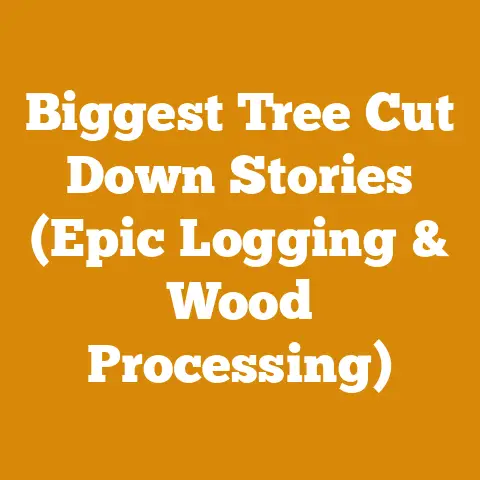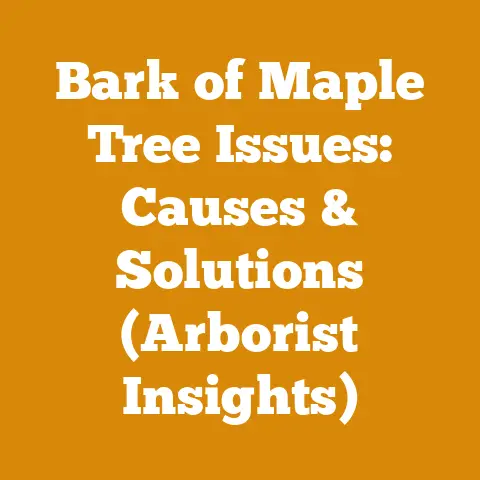Poulan 245A for Sale: Best Chainsaw Deals (5 Pro Tips)
Let’s talk about future-proofing your wood processing setup. Whether you’re a seasoned logger or just starting to explore the world of firewood, investing in the right tools and knowledge is key to maximizing efficiency and minimizing headaches. Today, I’m diving deep into the Poulan 245A chainsaw – a model that has seen its share of use, and one that presents both opportunities and potential pitfalls for buyers. We’ll explore how to snag the best deals and equip you with five pro tips to make an informed decision. My aim is to guide you through the process, ensuring you don’t just buy a chainsaw, but invest in a reliable tool that serves you well for years to come.
Poulan 245A for Sale: Unearthing the Best Chainsaw Deals & 5 Pro Tips
The Poulan 245A is a chainsaw model that evokes a certain nostalgia. It’s a classic, and while it’s not the newest kid on the block, it can still be a valuable tool in the right hands. However, buying a used chainsaw, especially one like the 245A, requires careful consideration. My experience has taught me that patience and knowledge are your best allies in this quest.
Why Consider a Poulan 245A?
There are several reasons why someone might be interested in a Poulan 245A, despite its age:
- Affordability: Used chainsaws are often significantly cheaper than new ones. This can be appealing for those on a tight budget.
- Simplicity: Older models like the 245A are generally simpler in design than modern chainsaws. This can make them easier to repair and maintain for those with mechanical aptitude.
- Power: The Poulan 245A was known for its decent power, making it suitable for a range of tasks, from felling small trees to cutting firewood.
- Availability of Parts: Although the model is older, parts are often still available online or through specialized repair shops.
However, it’s crucial to understand the potential downsides before making a purchase.
Potential Pitfalls of Buying a Used Chainsaw
Buying a used chainsaw is not without its risks:
- Wear and Tear: The chainsaw may have been used extensively and could be nearing the end of its lifespan.
- Hidden Problems: There could be underlying issues that are not immediately apparent, such as a worn piston, damaged crankshaft, or faulty ignition system.
- Safety Concerns: An improperly maintained chainsaw can be dangerous to operate.
- Lack of Warranty: Used chainsaws typically do not come with a warranty, so you’re buying it “as is.”
Where to Find Poulan 245A Chainsaws for Sale
Several avenues exist for finding a Poulan 245A for sale:
- Online Marketplaces: Websites like eBay, Craigslist, and Facebook Marketplace are popular platforms for buying and selling used equipment.
- Local Classifieds: Check local newspapers, community bulletin boards, and online classifieds for listings in your area.
- Pawn Shops: Pawn shops sometimes carry used chainsaws.
- Garage Sales and Estate Sales: Keep an eye out for garage sales and estate sales in your neighborhood, as these can be a good source of used tools.
- Repair Shops: Chainsaw repair shops may occasionally have used chainsaws for sale that they have refurbished.
Pro Tip #1: Thorough Inspection is Key
Before even considering the price, a meticulous inspection is paramount. Don’t rely solely on pictures or the seller’s description. If possible, inspect the chainsaw in person.
What to Look For:
- External Condition: Check for any signs of damage, such as cracks, dents, or missing parts. Pay close attention to the chain brake handle, throttle trigger, and safety interlocks.
- Chain and Bar: Examine the chain for sharpness, wear, and proper tension. The bar should be straight and free of damage. Look for excessive wear on the bar rails.
- Engine Compression: Pull the starter cord slowly. You should feel significant resistance, indicating good engine compression. A lack of compression suggests a worn piston or cylinder. A compression tester can provide a definitive reading – ideally, it should be within the manufacturer’s specifications (typically 120-150 PSI for a chainsaw of this type).
- Fuel and Oil Leaks: Inspect the fuel and oil tanks for leaks. Look for signs of fuel or oil around the carburetor, fuel lines, and oil pump.
- Air Filter: Remove the air filter and check its condition. A dirty or damaged air filter can restrict airflow and cause engine problems.
- Spark Plug: Inspect the spark plug. A fouled or damaged spark plug can indicate engine problems. The color of the spark plug can also provide clues about the engine’s condition. A light tan color is ideal, while a black or oily spark plug suggests a problem.
Why This Matters: A thorough inspection can reveal hidden problems that could cost you money and time down the road. I once bought a chainsaw that looked great on the outside but had a cracked engine casing. The repair cost more than the chainsaw was worth.
Actionable Steps:
- Bring a flashlight and a small toolkit with you when inspecting the chainsaw.
- Ask the seller if you can start the chainsaw and run it for a few minutes.
- Take detailed notes and photos of any issues you find.
Pro Tip #2: Start It Up and Listen Carefully
A running chainsaw tells a story. Starting the chainsaw and listening to the engine is crucial for assessing its condition.
What to Listen For:
- Ease of Starting: A healthy chainsaw should start relatively easily, usually within a few pulls of the starter cord. Excessive pulling or difficulty starting can indicate a problem.
- Idle Speed: The engine should idle smoothly without stalling or racing. An erratic idle speed can indicate a carburetor problem or an air leak.
- Acceleration: The engine should accelerate smoothly and quickly when you squeeze the throttle trigger. Hesitation or bogging down can indicate a fuel delivery problem.
- Engine Noise: Listen for any unusual noises, such as knocking, rattling, or hissing. These noises can indicate internal engine damage.
- Smoke: Observe the color of the exhaust smoke. Excessive smoke, especially black or blue smoke, can indicate engine problems. Black smoke suggests a rich fuel mixture, while blue smoke suggests oil burning.
Why This Matters: The way a chainsaw starts and runs is a direct reflection of its internal health. A chainsaw that struggles to start, idles poorly, or makes unusual noises is likely to require repairs. I recall a time when I ignored a slight knocking sound in a chainsaw engine. Within weeks, the engine seized completely, requiring a costly rebuild.
Actionable Steps:
Don’t be afraid to haggle, especially if you find any issues during your inspection.
How to Negotiate:
- Research the Market Value: Before making an offer, research the market value of similar Poulan 245A chainsaws in your area. Check online marketplaces and classifieds to get an idea of the going rate.
- Point Out Any Flaws: Use any flaws you find during your inspection as leverage to negotiate a lower price. Be specific and provide evidence to support your claims.
- Be Prepared to Walk Away: Don’t be afraid to walk away if the seller is unwilling to negotiate a fair price. There are plenty of other chainsaws out there.
- Offer a Fair Price: Make a reasonable offer based on the chainsaw’s condition and market value. Don’t try to lowball the seller, as this could offend them and prevent you from reaching an agreement.
- Be Polite and Respectful: Even if you’re negotiating a lower price, be polite and respectful to the seller. This will increase your chances of reaching a successful agreement.
Why This Matters: Negotiation is a crucial part of buying a used chainsaw. By doing your research and being prepared to walk away, you can ensure that you’re getting a fair price. I once saved over $50 on a used chainsaw by pointing out a minor issue with the chain brake.
Actionable Steps:
- Research the market value of similar chainsaws.
- Identify any flaws during your inspection.
- Be prepared to walk away if the seller is unwilling to negotiate.
Pro Tip #4: Check Parts Availability and Pricing
Before you buy, ensure replacement parts are readily available and reasonably priced.
How to Check Parts Availability:
- Online Parts Retailers: Check online parts retailers like eBay, Amazon, and specialty chainsaw parts websites.
- Local Repair Shops: Contact local chainsaw repair shops to inquire about parts availability.
- Poulan Website: Check the Poulan website for parts diagrams and availability information.
What to Consider:
- Common Wear Items: Focus on the availability and price of common wear items, such as chains, bars, spark plugs, air filters, and fuel filters.
- Critical Engine Parts: Check the availability of critical engine parts, such as pistons, cylinders, and crankshafts.
- Aftermarket Parts: Consider aftermarket parts as an alternative to OEM parts. Aftermarket parts are often cheaper and may be of comparable quality.
Why This Matters: Owning a chainsaw for which parts are scarce or expensive can be a nightmare. A simple repair can turn into a major headache if you can’t find the necessary parts. I learned this the hard way when I bought a vintage chainsaw and later discovered that the only way to get a replacement carburetor was to buy another used chainsaw.
Actionable Steps:
- Identify common wear items and critical engine parts.
- Check the availability and price of these parts online and at local repair shops.
- Consider aftermarket parts as an alternative to OEM parts.
Pro Tip #5: Safety First – Always!
Never compromise on safety. Ensure the chainsaw is equipped with all safety features and that you have the necessary safety gear.
Essential Safety Features:
- Chain Brake: The chain brake is a critical safety feature that stops the chain instantly in the event of a kickback. Ensure the chain brake is functioning properly.
- Throttle Lockout: The throttle lockout prevents accidental acceleration of the chain. Ensure the throttle lockout is functioning properly.
- Chain Catcher: The chain catcher prevents the chain from flying back towards the operator in the event of a chain breakage.
- Hand Guards: Hand guards protect the operator’s hands from branches and debris.
Essential Safety Gear:
- Helmet: A helmet protects your head from falling branches and debris.
- Eye Protection: Safety glasses or a face shield protect your eyes from flying debris.
- Hearing Protection: Earplugs or earmuffs protect your hearing from the loud noise of the chainsaw.
- Gloves: Gloves protect your hands from cuts and abrasions.
- Chainsaw Chaps: Chainsaw chaps protect your legs from chainsaw cuts.
- Steel-Toed Boots: Steel-toed boots protect your feet from falling logs and other hazards.
Why This Matters: Chainsaw operation is inherently dangerous. Taking the necessary safety precautions can significantly reduce your risk of injury. I’ve witnessed firsthand the devastating consequences of chainsaw accidents, and I can’t stress enough the importance of safety.
Actionable Steps:
- Inspect the chainsaw’s safety features to ensure they are functioning properly.
- Purchase and wear all necessary safety gear.
- Familiarize yourself with safe chainsaw operating procedures.
Understanding the Poulan 245A Specifications
Knowing the key specifications of the Poulan 245A can help you assess its suitability for your needs. While exact specifications may vary slightly depending on the year of manufacture, here’s a general overview:
- Engine Displacement: Around 45cc. This is a mid-range displacement, suitable for a variety of tasks.
- Bar Length: Typically came with a 16-inch or 18-inch bar.
- Weight: Around 12-13 pounds (without fuel and bar/chain).
- Fuel Capacity: Approximately 16 ounces.
- Oil Capacity: Approximately 8 ounces.
- Chain Pitch: Usually 0.325 inch.
- Chain Gauge: Typically 0.050 inch.
Why This Matters: These specifications provide a baseline for understanding the chainsaw’s capabilities. For example, the engine displacement indicates its power output, while the bar length determines the size of trees it can handle.
Actionable Steps:
- Confirm the specifications of the specific Poulan 245A you are considering.
- Compare these specifications to your intended use to ensure the chainsaw is suitable for your needs.
Common Problems and Repairs for the Poulan 245A
Knowing the common problems associated with the Poulan 245A can help you identify potential issues during your inspection and make informed decisions about repairs.
- Carburetor Problems: The carburetor is a common source of problems in older chainsaws. It can become clogged with dirt and debris, leading to starting problems, poor idling, and stalling.
- Fuel Line Issues: Fuel lines can crack and deteriorate over time, leading to fuel leaks and poor engine performance.
- Ignition Problems: The ignition system can fail, preventing the chainsaw from starting. Common ignition problems include a faulty spark plug, coil, or ignition module.
- Piston and Cylinder Wear: Over time, the piston and cylinder can wear down, leading to reduced engine compression and power.
- Oil Pump Problems: The oil pump can fail, preventing the chain from being lubricated properly. This can lead to premature chain and bar wear.
Why This Matters: Being aware of these common problems can help you diagnose issues and estimate repair costs.
Actionable Steps:
- During your inspection, pay close attention to these potential problem areas.
- If you suspect a problem, research the repair costs and factor them into your negotiation.
Maintaining Your Poulan 245A for Longevity
Proper maintenance is essential for extending the life of your Poulan 245A.
- Regular Cleaning: Clean the chainsaw regularly to remove dirt, debris, and sawdust. Pay particular attention to the air filter, cooling fins, and chain brake mechanism.
- Air Filter Maintenance: Clean or replace the air filter regularly. A dirty air filter can restrict airflow and cause engine problems. I recommend cleaning the air filter after every 5-10 hours of use.
- Spark Plug Maintenance: Clean or replace the spark plug regularly. A fouled spark plug can cause starting problems and poor engine performance.
- Chain Sharpening: Keep the chain sharp. A dull chain is not only less efficient but also more dangerous. Learn how to sharpen the chain yourself or take it to a professional.
- Chain Lubrication: Ensure the chain is properly lubricated. A dry chain will wear out quickly and can damage the bar.
- Fuel and Oil Storage: Store fuel and oil in approved containers and keep them away from heat and open flames. Use fresh fuel and oil. Old fuel can become stale and cause engine problems. I always add a fuel stabilizer to my gasoline, especially if I know the chainsaw will be stored for an extended period.
- Proper Storage: Store the chainsaw in a dry, protected location. Drain the fuel tank before storing the chainsaw for an extended period.
Why This Matters: Regular maintenance can prevent costly repairs and extend the life of your chainsaw. I’ve seen chainsaws that have lasted for decades with proper care.
Actionable Steps:
- Establish a regular maintenance schedule for your Poulan 245A.
- Follow the manufacturer’s recommendations for maintenance procedures.
Alternatives to the Poulan 245A
If, after considering all the factors, you decide that the Poulan 245A is not the right chainsaw for you, there are several alternatives to consider.
- New Entry-Level Chainsaws: Consider purchasing a new entry-level chainsaw from a reputable brand. These chainsaws are often more reliable and come with a warranty. Brands like Stihl, Husqvarna, and Echo offer excellent entry-level models.
- Used Chainsaws from Reputable Brands: Look for used chainsaws from reputable brands in good condition. Even a used Stihl or Husqvarna can be a better investment than a poorly maintained Poulan 245A.
- Electric Chainsaws: Electric chainsaws are a good option for light-duty tasks around the home. They are quieter, easier to start, and require less maintenance than gas-powered chainsaws.
- Cordless Chainsaws: Cordless chainsaws offer the convenience of electric power with the portability of gas-powered chainsaws. They are a good option for small to medium-sized tasks.
Why This Matters: It’s important to consider all your options before making a purchase. The Poulan 245A may not be the best choice for everyone.
Actionable Steps:
- Research alternative chainsaw models.
- Compare the features, performance, and price of different models.
- Choose the chainsaw that best meets your needs and budget.
Case Study: Restoring a Poulan 245A
I once acquired a neglected Poulan 245A from a friend who was moving. It hadn’t been used in years and was in rough shape. The chain was rusty, the carburetor was clogged, and the fuel lines were cracked. However, I saw potential in it.
The Restoration Process:
- Disassembly and Cleaning: I completely disassembled the chainsaw and cleaned all the parts thoroughly.
- Carburetor Rebuild: I rebuilt the carburetor with a new kit.
- Fuel Line Replacement: I replaced all the fuel lines.
- Spark Plug Replacement: I installed a new spark plug.
- Chain Sharpening: I sharpened the chain.
- Reassembly and Testing: I reassembled the chainsaw and tested it.
The Results:
After the restoration, the Poulan 245A ran like new. It started easily, idled smoothly, and had plenty of power. I used it for several years for cutting firewood and clearing brush.
Lessons Learned:
This experience taught me that even a neglected chainsaw can be restored with some time, effort, and knowledge. However, it also reinforced the importance of thorough inspection and maintenance.
Actionable Steps:
- If you’re considering restoring a Poulan 245A, be prepared to invest time and effort.
- Research the necessary repair procedures and acquire the necessary tools and parts.
The Importance of Proper Filing Techniques
Maintaining a sharp chain is paramount for both efficiency and safety. I’ve seen firsthand how a dull chain can lead to increased cutting time, wasted energy, and even dangerous kickbacks.
Filing Techniques:
- Round File Filing: This involves using a round file to sharpen each cutter tooth individually. The file size should match the chain pitch.
- Flat File Filing: This involves using a flat file to lower the depth gauges (rakers) on the chain.
- Using a Filing Guide: A filing guide can help you maintain the correct filing angle and depth.
Why This Matters: Proper filing ensures that the chain cuts smoothly and efficiently. It also reduces the risk of kickback.
Actionable Steps:
- Learn how to sharpen your chainsaw chain using the appropriate filing techniques.
- Invest in a good quality filing kit.
- Practice your filing skills regularly.
Understanding Timber Grading
If you plan to use your Poulan 245A for felling trees, understanding timber grading is essential for maximizing the value of your wood. Timber grading involves assessing the quality of the wood based on factors such as species, size, and defects.
Timber Grading Factors:
- Species: Different wood species have different properties and values.
- Size: Larger logs generally have a higher value.
- Defects: Defects such as knots, cracks, and rot can reduce the value of the wood.
Why This Matters: Understanding timber grading can help you identify the most valuable trees to harvest and maximize your profits.
Actionable Steps:
- Learn about the timber grading standards in your region.
- Consult with a timber buyer or forester to get their advice on timber grading.
Safe Felling Techniques
Felling trees is a dangerous task that should only be undertaken by experienced individuals. Always prioritize safety and follow proper felling techniques.
Safe Felling Practices:
- Assess the Tree: Before felling a tree, assess its size, lean, and any potential hazards.
- Plan Your Escape Route: Plan a clear escape route away from the falling tree.
- Use Proper Cutting Techniques: Use proper cutting techniques, such as the undercut and back cut.
- Be Aware of Your Surroundings: Be aware of your surroundings and any potential hazards, such as power lines or other trees.
Why This Matters: Safe felling techniques can prevent serious injuries and fatalities.
Actionable Steps:
- Get proper training in safe felling techniques.
- Always wear appropriate safety gear.
- Never fell trees alone.
Conclusion: Making an Informed Decision
Buying a used Poulan 245A chainsaw can be a cost-effective way to acquire a useful tool. However, it’s crucial to approach the purchase with caution and knowledge. By following these five pro tips – thorough inspection, careful listening, confident negotiation, parts availability checks, and prioritizing safety – you can significantly increase your chances of finding a reliable chainsaw that meets your needs and budget. Remember, patience and due diligence are your best friends in the used chainsaw market. Happy cutting!






